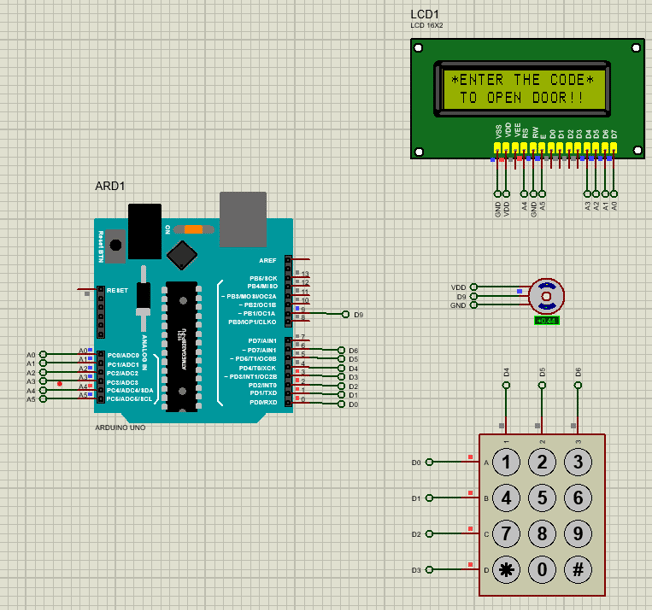Password Based Door Locking System Using Arduino


A Password-Based Door Locking System using Arduino is an innovative security solution that allows access control through a digital password rather than traditional keys. This system comprises several components, including an Arduino microcontroller, a keypad, an LCD display, and a locking mechanism such as a solenoid lock.
Note: You can download the project files, source code, and find purchase links for all components below👇
Password Based Door Locking System using Arduino represents a modern approach to home and office security, combining simplicity with advanced technology. This system leverages the Arduino microcontroller's versatility to manage and control access through a digital password, ensuring that only authorized individuals can unlock the door.
Components:
Arduino Microcontroller🛒: The brain of the system that processes input and controls the locking mechanism.
Keypad🛒: Used by the user to input the password. Typically, a 4x4 matrix keypad is used.
LCD Display🛒: Shows the status messages and guides the user through the process.
Solenoid Lock🛒: An electrically controlled lock that engages or disengages based on the input receive or you can also go with servo motor🛒
Power Supply🛒: Powers all the components of the system.
Connecting Wires and Resistors🛒: Facilitate the connections between components.
Working Principle:
Password Entry: The user enters a pre-defined password using the keypad.
Password Verification: The Arduino microcontroller compares the entered password with the stored password.
Access Granted/Denied:
If the password matches, the Arduino sends a signal to the solenoid lock/servo motor to disengage, unlocking the door. The LCD displays a message indicating that access is granted.
If the password is incorrect, the lock remains engaged, and the LCD displays an "Access Denied" message.
Reset and Lock: After a brief period, the system resets, re-engaging the lock to ensure security.
Circuit Connections:
Keypad Connections :
R1 to Digital Pin 0
R2 to Digital Pin 1
R3 to Digital Pin 2
R4 to Digital Pin 3
C1 to Digital Pin 4
C2 to Digital Pin 5
C3 to Digital Pin 6
LCD Connections:
RS to Analog Pin 4
E to Analog Pin 5
D4 to Analog Pin 3
D5 to Analog Pin 2
D6 to Analog Pin 1
D7 to Analog Pin 0
VSS to GND
VDD to +5V
V0 (contrast) to the middle pin of a 10k potentiometer
RW to GND
Servo Motor:
Signal pin to Digital Pin 9
VCC to +5V
GND to GND
Download the arduino code from here✋:
Download the proteus project from here✋:
Additional Features:
Change Password: An option can be provided to change the password through a special administrative mode.
Security Alert: The system can be programmed to trigger an alarm after a certain number of incorrect attempts.
Battery Backup: Ensures that the system remains operational during power outages.
Benefits:
Enhanced Security: Provides a secure method of entry that is harder to bypass than traditional locks.
Convenience: Eliminates the need to carry keys, reducing the risk of losing them.
Customizability: The system can be tailored to include additional features such as remote access control and integration with smart home systems.
Applications:
Residential Homes: For securing main doors, garage doors, and other entry points.
Commercial Buildings: To control access to offices, storage rooms, and restricted areas.
Institutions: Useful in schools, colleges, and other institutions for securing labs, libraries, and administrative offices.
A Password-Based Door Locking System using Arduino is a robust, user-friendly, and highly effective security solution that leverages digital technology to enhance traditional locking mechanism
Feel free to reach out with any suggestions🤔 or project ideas 💡 at "virtualengineerve@gmail.com"
or leave a comment on our YouTube video.


